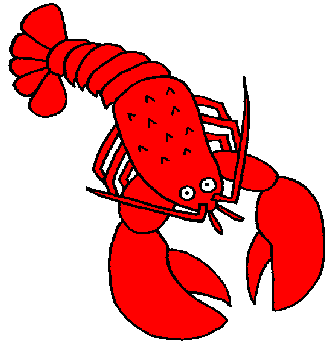 Lobsters
Lobsters
 Lobsters
Lobsters
Go to these web sites to find out more about lobsters:
http://www.woodmans.com/100-lobster-facts/
http://animals.nationalgeographic.com/animals/invertebrates/lobster/
http://maine-lobster.com/lobster-facts
http://offshorelobster.org/main/lobster-facts
http://www.lobstermanspage.net/lobstrs/lfacts.jsp
Find out:
1. What is the Latin name for the lobster? What is another name for the lobster?
2. The lobster is a crustacean. What are three other crustaceans?
3. What do lobsters eat?
4. Where do small lobsters live?
5. A 5-pound female lobster would carry approximately how many eggs?
6. From every 100,000 eggs, about how many lobsters will survive?
7. What is molting?
8. How can you tell how old a lobster is?
9. Lobsters must have a certain carapace size to be caught legally.
What is that size?
10. What are some of the colors of different lobsters?11. The lobster has no cerebral cortex. What does this mean?
12. How do lobsters smell their food?
|
Do More
Research about Lobsters:
Gulf of Maine Aquarium
- History of lobsters A Lobster's Life -
Lobstering -
http://www.lobstermanspage.net/lbstrng/lgfact.jsp
|
Find the picture that shows the parts
of the lobster's body at:
http://www.enchantedlearning.com/subjects/invertebrates/crustacean/Lobsterprintout.shtml
http://www.lobstermanspage.net/lobstrs/lfacts.html
Draw the lobster body parts and label them below.
Back to
Mrs.
Mitchell's Virtual School
This page was developed by Kathi
Mitchell
and was last updated March 11, 2016
Answers:
1. Homarus Americanus. Massachusetts lobster, Maine lobster, Canadian lobster, North American lobster, or King of Seafood.
2. Crabs, shrimp, crayfish, water fleas, copepods, barnacles
3. Fresh food such as fish, crabs, clams, mussels, sea urchins and other lobsters
4. In the sea weeds and rocky habitat
5. 40,000 eggs
6. Four
7. Molting is also called shell-shedding. Lobsters pull themselves out of their old shells, absorb water, and develop a new shell.
8. You can't tell the age of a lobster
9. More than 3 1/4 inches
10. Dark green, blue, yellow, red, white
11. This means he cannot feel pain
12. They use four small antennae on their head and small
sensing hairs all over their body.